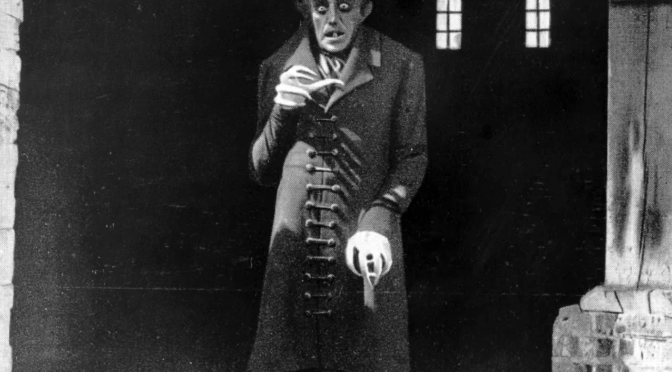Since its 1922 release, F.W. Murnau’s NOSFERATU has been subject to as much mythology and folklore as the original vampire legend itself. Illegally and ‘freely’ based on Bram Stoker’s book, Dracula, Stoker’s widow Florence, incensed by financial motivation, won a court order to have the prints and negatives of the film destroyed – by exposing them to sunlight, one would hope.
The film’s own legend is drawn from its many, often contradictory, analyses, as academics and film enthusiasts try to make their own mark on its interpretation. The vampire Nosferatu has been seen as a representation of the Nazi party – a prescient warning, the monster parasite sucking the blood from the virginal Weimar Republic – but also as anti-Semitic. The exaggerated make-up and features of the vampire give him an appearance not indistinct from the loathsome caricatures of Jews of that era. However, Murnau’s deliberate decision to set the film 50 years earlier than the book gives a medieval atmosphere, and the Great Death of Wisborg, referred to in the film only, lends associations of the plague.
Jews were blamed for the outbreak of the Black Death, and were considered demonic in the Christian world. Nosferatu as a pervasive influence from the east? Or from the west? Is the vampire the incarnation of the Allied Powers who, at Versailles, drew up the treaty which bled the fledgling democracy of the German republic dry? Further interpretations lend themselves to the vampire genre’s awkward relationship with homosexuality. Murnau himself was homosexual, and aspersions have been long been cast over Stoker’s closeted sexuality. This was mainly due to his friendships with Walt Whitman and Oscar Wilde, but also to the vivid homoerotic imagery in the Dracula book. This imagery is, however, absent in Murnau’s film. In the infamous scene at the Count’s Castle, Hutter (for which read Harker) cuts himself on his finger, not near his mouth; and as a result, Nosferatu doesn’t grab for his guest’s throat.

“Murnau and other German expressionists were also informed by the ideas of Freud and of the Romantic movement in Germany, and the dark, irrational forces that stir within us all.”
However, given that the aesthetic choices employed by Murnau rely on a series of dichotomies, it might be worthwhile to concentrate on an interpretation in this vein. Heavily present throughout the film is the contrast between rational and irrational, light and dark – the presence of the shadow self. Produced towards the end of a period of unprecedented modernity, it is possible to discern the changing of the times within the film; the passing of an older way of life, of superstition and tradition. Hutter dismisses the warnings of the villagers and the book he is given on vampires, and must face the consequences. The spiritual becomes separated from reality and we are lost.
Murnau and other German expressionists were also informed by the ideas of Freud and of the Romantic movement in Germany, and the dark, irrational forces that stir within us all. Often scorned for breaking the rules by having Nosferatu cast a shadow, Murnau was an art historian and likely to carefully consider elements of composition. The shadow of the vampire was not an oversight. Murnau is instead casting doubt on the stark delineation between fantasy and reality, and between the rational and the irrational. What else are the undead but somnambulists, inhabiting for all eternity a terrifying state that we both fear and desire: the waking dream.
NOSFERATU screens at 18:30 on Saturday 28th September with live musical accompaniment from Neil Brand. Click here to book tickets.


Seeing it, again, after the Festival, I have fallen under the spell of this story, with 1,200 words to-night on the blog…